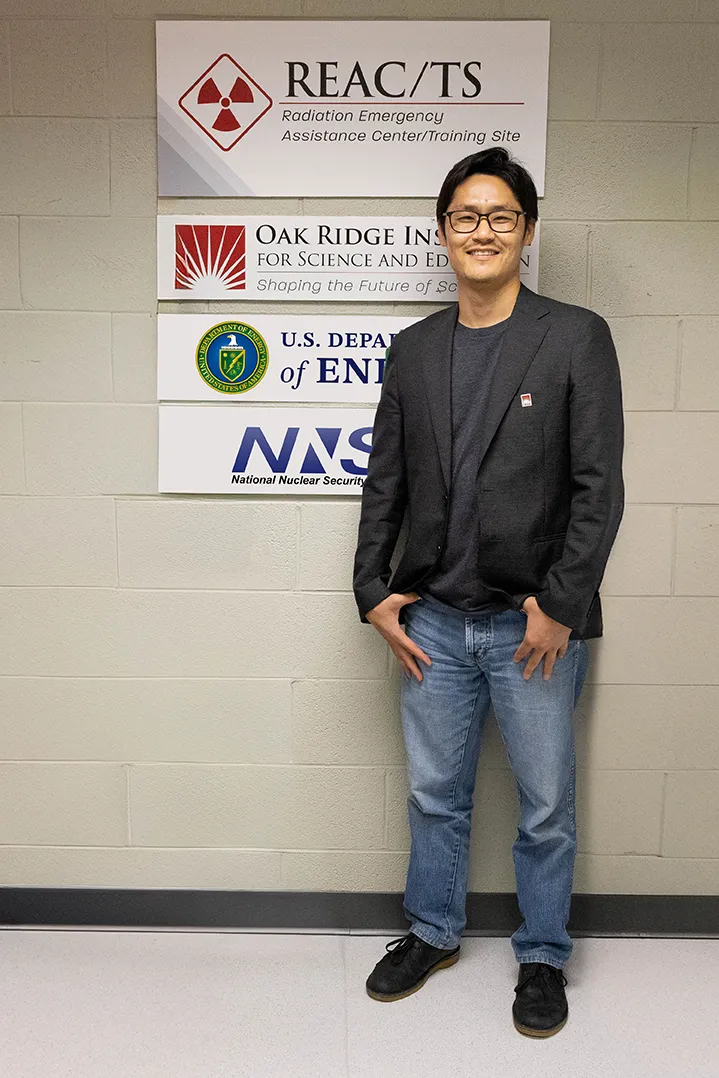Physician scientist from Japan visits REAC/TS and the CBL to study advances in treatments for aggressive brain cancer

Dr. Anarkhuu Bold-Erdene
Malignant gliomas, a type of aggressive brain cancer, are extremely difficult to treat, especially after a recurrence.
Anarkhuu Bold-Erdene, M.D, who recently completed a month-long internship at the Radiation Emergency Assistance Center/Training Site (REAC/TS) and the Cytogenetic Biodosimetry Laboratory (CBL), is researching ways to improve the treatment and survivability of patients with malignant gliomas.
Bold-Erdene is a doctoral student in radiation biology in the Phoenix Leadership Program at Hiroshima University. During his visit to REAC/TS and the CBL, he participated in Radiation Emergency Medicine and Health Physics courses to learn important aspects of emergency medical management of radiation induced injuries. Additionally, he has also gained knowledge of various biodosimetry assays including the analysis of dicentric chromosomes for the construction of radiation dose response curves and radiation dose estimation. During his time at the CBL, Bold-Erdene also got the opportunity to learn about the automated equipment (chromosome harvester and spreader) which the CBL uses for high throughput sample processing.
“Most of the automated equipment CBL currently has is made in Japan but we don’t have it,” he joked.
During his visit, Bold-Erdene also visited the proton therapy center at Covenant Health’s Thompson Cancer Survival Center as well as the Nuclear Engineering Department at the University of Tennessee, Knoxville that has various irradiation sources including neutrons.
Bold-Erdene’s research focuses on the use of radiation sensitizers to improve the treatment for gliomas. Radiation sensitizers are medications that enhance the cancer-killing power of radiation therapy while protecting healthy cells from potential damage.
“Gliomas are very difficult to treat and mostly recure after radiation treatment,” he said. “If the tumor recurs, there is basically no treatment. I’m currently researching on new radiation sensitizers that can substantially enhance the effect of tumor cell killing. Maybe I will have some promising results when my future research is complete. Hopefully, my research will pave the way for better treatment strategies.”
Prior to pursuing his Ph.D., Bold-Erdene was a practicing as a pathologist for 10 years at the National Cancer Center Hospital in Mongolia.
Bold-Erdene grew up in Mongolia and studied medicine at the Mongolian National University for Medical Sciences. After graduation, he spent a year in Tokyo, Japan, before returning to Mongolia where he did one year of residency in pathology and then became a professional pathologist.
From as far back as middle school, Bold-Erdene knew he wanted to become a doctor, adding that his mother liked the idea of him becoming a doctor. He has two brothers, both of whom work in finance.
“My purpose was to become a doctor but, of course, not a pathologist. I chose pathology because I like scientific things,” he said.
Bold-Erdene doesn’t see patients, but he does see their samples, which he says can give more information about patients pertaining to what is or was happening medically.
Bold-Erdene came to REAC/TS for his internship at the recommendation of his professors, Nobuyuki Hirohashi, M.D., Ph.D., and Osamu Kaminuma, Ph.D. Hirohashi knows Carol Iddins, M.D., director of REAC/TS, and had been trained by Iddins and the REAC/TS team; and Kaminuma is Bold-Erlene’s research supervisor. While his doctoral thesis focuses on radiation biology, he was not familiar with radiation emergency response, which is dramatically different from general medical emergency response.
“The world is changing, and there are so many additional possibilities for radiation emergencies. You just never know. We must prepare for it,” Bold-Erdene said.
He said he enjoyed learning about the automated equipment and biodosimetry techniques from Adayabalam Balajee, Ph.D., director of the CBL. The method for processing and examining samples for dicentric chromosomes (a key indication of radiation dose exposure) in the CBL moves much faster than back home, and Bold-Erdene has hopes that samples will be processed even faster in the future to expedite the absorbed dose estimation process.
As might be expected, the ways people talk about radiation, and even the samples that are collected, are different in the United States and Japan. Because of the nuclear warheads dropped over Hiroshima and Nagasaki, the scientific culture in Japan is much more radiation focused.
“So much research is radiation-related and most of the reputed institutes studying radiation are located in Hiroshima,” he said, “because we can learn so much from the vast amount of survivor data and different exposure levels.”
Following his internship, Bold-Erdene returned to Japan with new skills, a stronger relationship with the REAC/TS and CBL teams, and increased knowledge to apply to his doctoral thesis.
Media Contacts
Pam Bonee
Director, Communications
Phone: 865.603.5142
pam.bonee@orau.org
Wendy West
Manager, Communications
Phone: 865.207.7953
wendy.west@orau.org
The Oak Ridge Institute for Science and Education (ORISE) is a U.S. Department of Energy (DOE) asset that is dedicated to enabling critical scientific, research, and health initiatives of the department and its laboratory system by providing world class expertise in STEM workforce development, scientific and technical reviews, and the evaluation of radiation exposure and environmental contamination.
ORISE is managed by ORAU, a 501(c)(3) nonprofit corporation and federal contractor, for DOE’s Office of Science. The single largest supporter of basic research in the physical sciences in the United States, the Office of Science is working to address some of the most pressing challenges of our time. For more information, please visit science.osti.gov.

